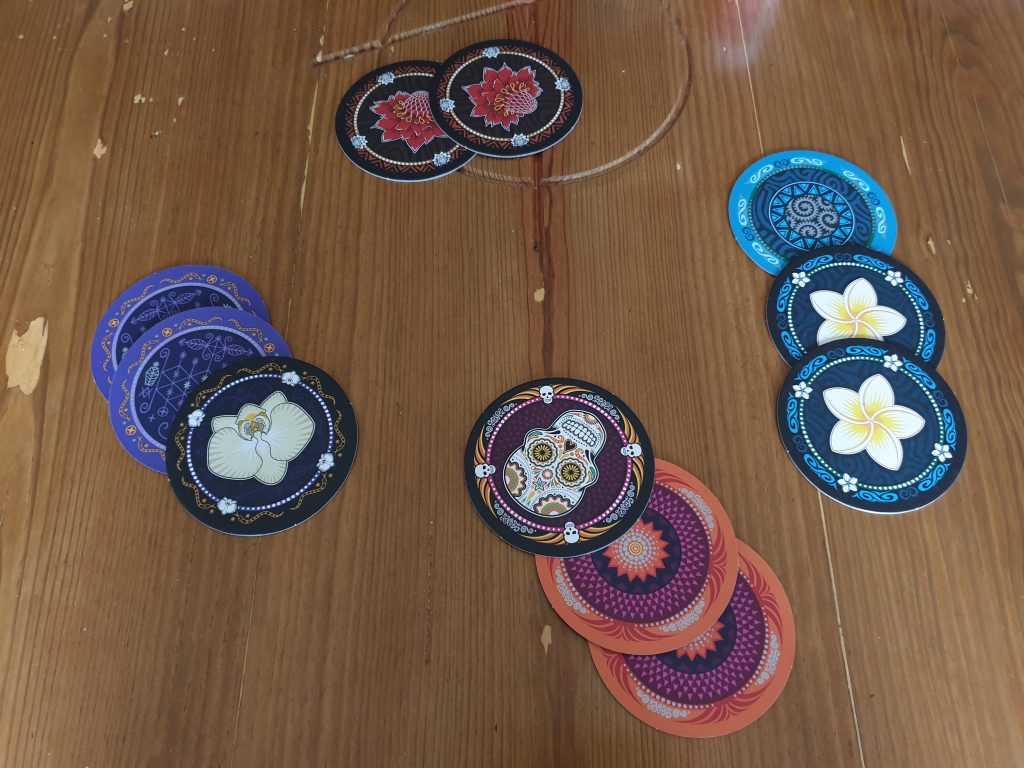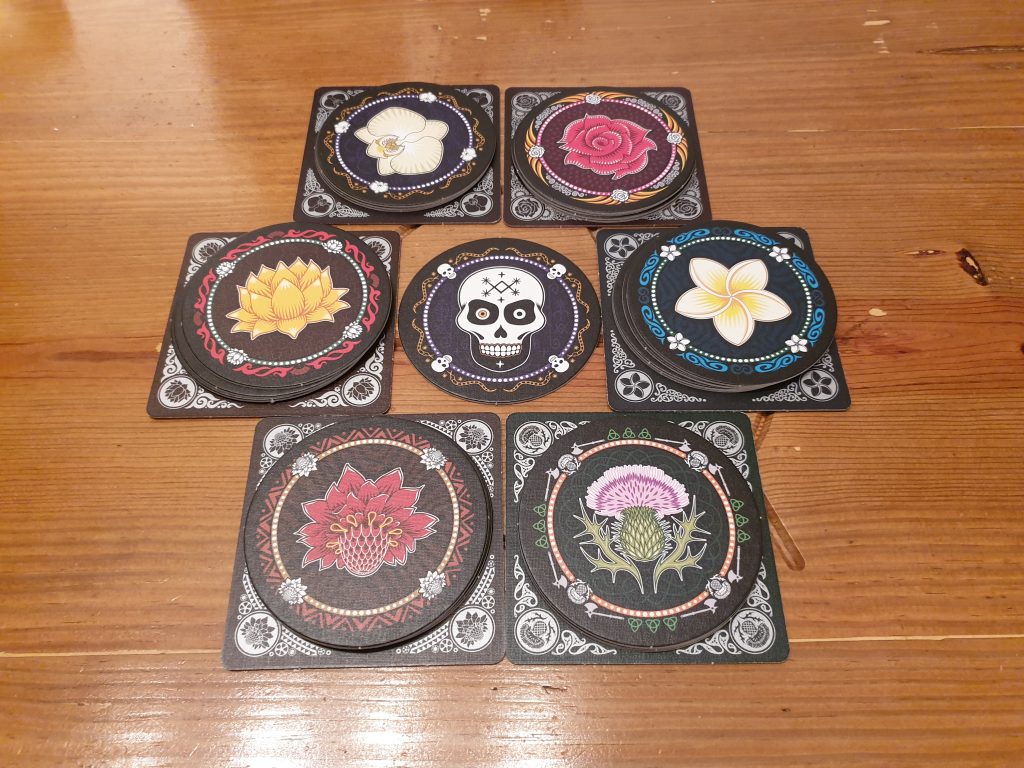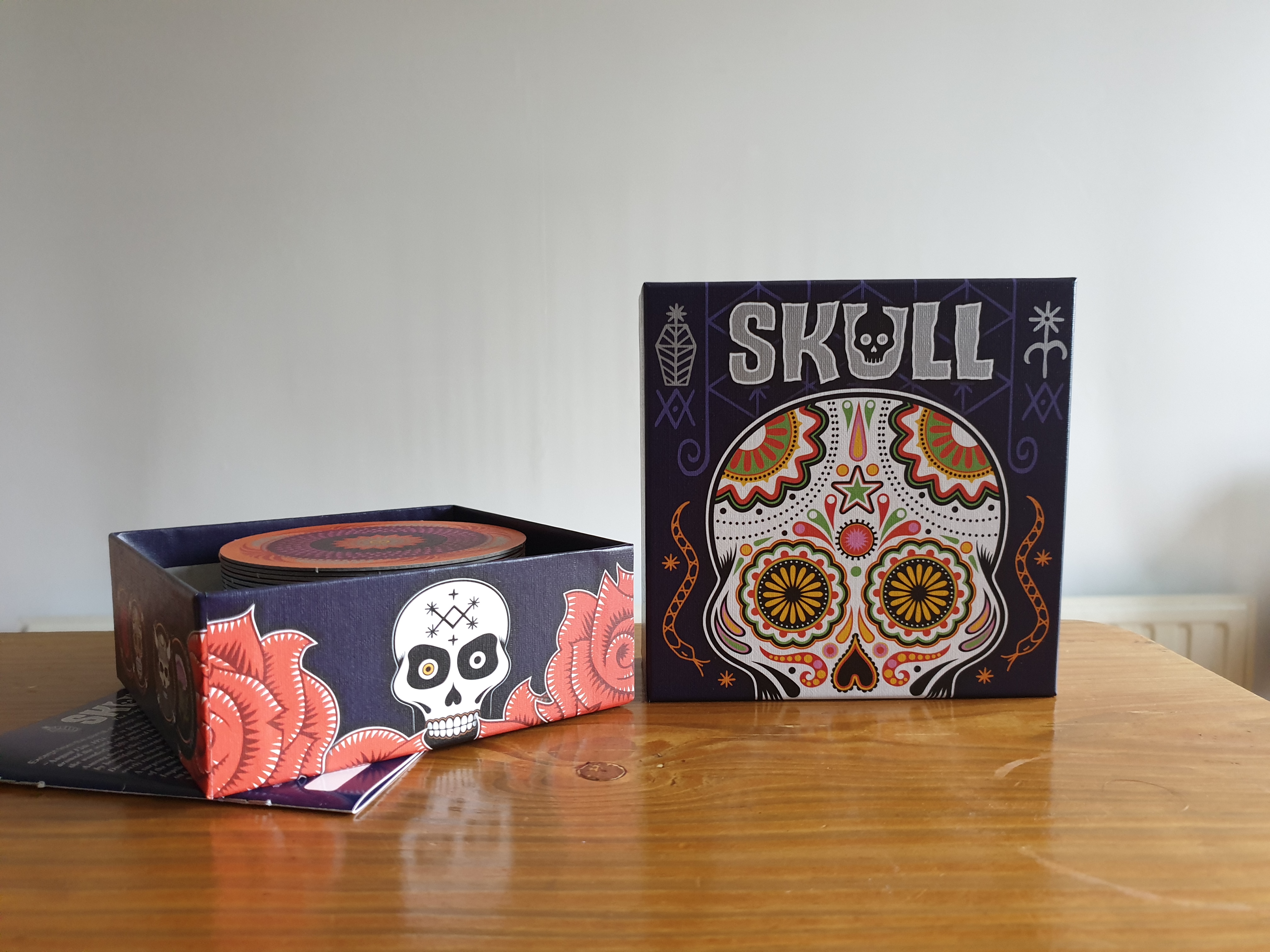Skull, originally released back in 2011, is a bluffing and bidding board game from Asmodee. Designed by Hervé Marly, featuring art from Rose Kipik and Thomas Vuarchex, the game sees 3 – 8 players flipping over tiles, bluffing their opponents and sometimes themselves accidentally. Also referred to as Skull & Roses, the tiles loosely represent biker gangs. However, is this a game to take on the road? Let’s find out!
Passing out 4 identically backed tiles and a game mat tile to each player is the extent of setup for Skull. Unsurprisingly, it takes a little longer to explain the rules but not by many seconds. The faces of the four tiles are not identical, with 3 featuring a rose (or flower) and 1 featuring a skull. At the start of each round all players put down one of their tiles. Tiles are played face down, so only the player that put it down knows what has been chosen.
Now the round truly begins. The starting player chooses to either play an additional tile, again face down or call a challenge. If an extra tile is placed, play moves clockwise around the table with the same option being made by the next player and so on. If a player does not have a tile to place or they choose to they can start a challenge. This is done by saying a number that is lower or equal to the number of tiles on the table.
The tile placement option is now removed, being replaced by a choice between passing or saying a number higher than the current challenge. When the maximum number, the number of tiles on the table, or everyone else has passed there will be a single challenger. The challenger must then turn the number of tiles over equal to the number they said. The twist is that they must turn over all of their own tiles before choosing to turn over the top tiles of other players one by one.

Finding only roses is the aim and doing so will let you flip your game mat over. More commonly a player will find a Skull. Whether it was their own or someone else’s it doesn’t matter, either way this will lose them a tile. Shuffling their tiles another player randomly chooses one of their tiles to discard, though only the owner of the tiles gets to see what is lost. If this causes their last tile to be discarded the player is out of the game. It is completely possible that your first tile lost is your Skull tile but best not to let on to your opponents. Play continues with a new round, with the challenger being the starting player, unless someone has flipped their game mat for a second time – winning them the game.
The game revolves around the art to bluff a friend, family member, colleague or stranger. Some people do find this awkward, almost embarrassing, at times. Encourage these gamers to come out of their shell a little and before you know it even those early gigglers will be bluffing you. A great way to start the ball rolling on this is playing a round while teaching. For many they want to just jump in and play, not even happy to sit through a minute long rules explanation. With Skull you’ll want to reset the game afterwards but playing a round explaining each stage as it comes up is not only possible it is an ideal way to teach the game.
Skull looks like it is a game from drink coasters, almost a pub game. This doesn’t do the game any harm though, really showing the game can be played anywhere, even with an extremely limited flat space. While it would have been nice for the tiles to have had some kind of waterproof coating – to ensure their survival at any location – it shows how even simple components can look nice. The sets of tiles didn’t need to have unique flowers and skulls, nor did they need patterns – different colours would have worked.
Player elimination can be problematic in some party games. While sidelining an opponent feels good being sat out for a long period of time really draws from the experience. Skull’s speed gets around this. Chances are, unless one player is constantly going all in, when a player is eliminated there are only a couple of minute long rounds to sit out for. Not being long keeps players engaged rooting for players that didn’t get them eliminated – driving a great atmosphere.

The game is certainly playable at 3, though Skull truly gets going at 4+. With 4+ higher numbered challenges become possible. Whilst possible they still seem as daring than even low level challenger bids at 3. Even at a player count of 6/7, as long as players think ahead, play is still quick enough for players to be getting multiple turns in the blink of an eye – ideal for maintaining the adrenaline rush the game creates. While it is possible to combine two sets to get a larger player count, I doubt 8 or more would maintain the speed that helps the game stay awesome.
If reading individual opponents expressions, almost poker-esque, isn’t for you Skull may not be either. In many deduction games – like the recently reviewed Deception Murder in Hong Kong – there may be another player around the table trying to help and hint at a players intensions. There is no such help in Skull. It keeps teaching the game to last seconds but can put others off – everyone is out for themselves.
With all the simplicity, Skull proves you don’t need crazy miniatures, grandiose components or an extensive list of mechanics to bring joy to a group of gamers. It is light fun that might not fit into every gaming day but is a title that can be brought out at many times, locations and events. Skull can last only minutes, which makes it extremely easy to say “just one more game” and watch the time fly by. Included in the box may be glorified cardboard coasters. Still, there are touches, like the patterns, that add to the experience, elevating what is a simple game above something most could do themselves and making it a worthy item to purchase.
[Editor’s Note: Skull was provided to us by Asmodee for review purposes. The game is currently available on 365 Games for £16.99. It is also available from local UK board game stores, find your local store here]

